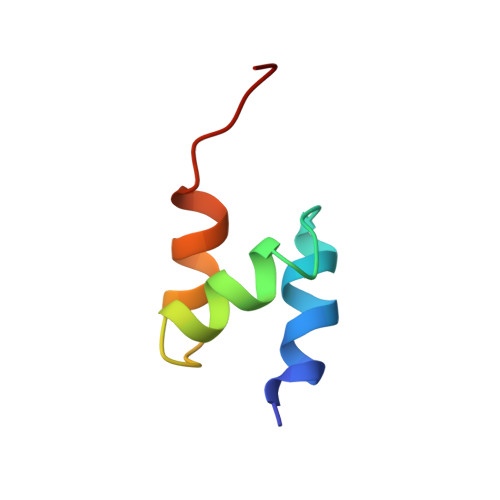Biochemical and structural analysis of the interaction between the UBA(2) domain of the DNA repair protein HHR23A and HIV-1 Vpr.
Withers-Ward, E.S., Mueller, T.D., Chen, I.S., Feigon, J.(2000) Biochemistry 39: 14103-14112
- PubMed: 11087358
- DOI: https://doi.org/10.1021/bi0017071
- Primary Citation of Related Structures:
1DV0, 1F4I - PubMed Abstract:
The DNA repair protein HHR23A is a highly conserved protein that functions in nucleotide excision repair. HHR23A contains two ubiquitin associated domains (UBA) that are conserved in a number of proteins with diverse functions involved in ubiquitination, UV excision repair, and signaling pathways via protein kinases. The cellular binding partners of UBA domains remain unclear; however, we previously found that the HHR23A UBA(2) domain interacts specifically with the HIV-1 Vpr protein. Analysis of the low resolution solution structure of HHR23A UBA(2) revealed a hydrophobic loop region of the UBA(2) domain that we predicted was the interface for protein/protein interactions. Here we present results of in vitro binding studies that demonstrate the requirement of this hydrophobic loop region for interaction with human immunodeficiency virus (HIV-1) Vpr. A single point mutation of the Pro at residue 333 to a Glu totally abolishes the binding of HIV-1 Vpr to UBA(2). High resolution NMR structures of the binding deficient UBA(2) mutant P333E as well as of the wild-type UBA(2) domain were determined to compare the effect of this mutation on the structure. Small but significant differences are observed only locally at the site of the mutation. The biochemical and structural analysis confirms the function of the HHR23A UBA(2) GFP-loop as the protein/protein interacting domain.
Organizational Affiliation:
Department of Microbiology, University of California at Los Angeles, Los Angeles, California 90095, USA.














